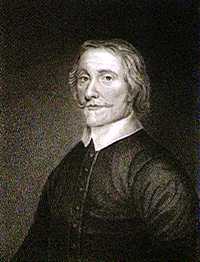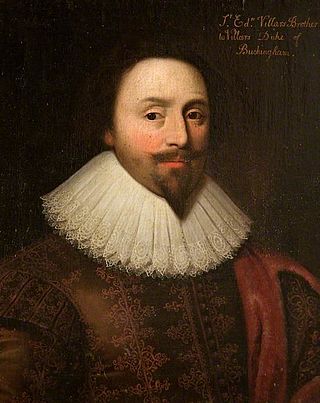Duke of Buckingham, referring to Buckingham, is an extinct title that has been created several times in the peerages of England, Great Britain, and the United Kingdom. There were creations of double dukedoms of Buckingham and Normanby and of Buckingham and Chandos. The last holder of the dukedom died in 1889.

Earl of Lichfield is a title that has been created three times, twice in the Peerage of England and once in the Peerage of the United Kingdom (1831). The third creation is extant and is held by a member of the Anson family.

Viscount Cobham is a title in the Peerage of Great Britain that was created in 1718. Owing to its special remainder, the title has passed through several families. Since 1889, it has been held by members of the Lyttelton family.

Earl of Cardigan is a title in the Peerage of England that was created by Charles II in 1661 for Thomas Brudenell, 1st Baron Brudenell, and the title has been held since 1868 by the Marquesses of Ailesbury. Since that time, it has been used as a courtesy title by the heir apparent to that Marquessate, currently Thomas Brudenell-Bruce, Earl of Cardigan, only son of the 9th Marquess.

Earl of Coventry is a title that has been created twice in the Peerage of England. The first creation for the Villiers family was created in 1623 and took its name from the city of Coventry. It became extinct in 1687. A decade later, the second creation was for the Coventry family and is still extant.

Earl of Jersey is a title in the Peerage of England. It is held by a branch of the Villiers family, which since 1819 has been the Child Villiers family.

Earl of Chichester is a title that has been created three times, twice in the Peerage of England and once in the Peerage of the United Kingdom. The current title was created in the Peerage of the United Kingdom in 1801 for Thomas Pelham, 2nd Baron Pelham of Stanmer.

Viscount Valentia is a title in the Peerage of Ireland. It has been created twice. The first creation came in 1621 for Henry Power. A year later, his kinsman Sir Francis Annesley, 1st Baronet, was given a "reversionary grant" of the viscountcy, which stated that on Power's death Annesley would be created Viscount Valentia. Annesley, a member of an influential Anglo-Irish family which descended from Newport Pagnell in the County of Buckinghamshire, was a favourite of James I, who granted him land in Ireland, notably the fort of Mountnorris in County Armagh. He was knighted in 1616, created a baronet, of Newport Pagnell in the County of Buckingham, in the Baronetage of Ireland in 1620 and Baron Mountnorris, of Mountnorris in the County of Armagh, in 1628.

Earl of Anglesey was a title in the Peerage of England during the 17th and 18th centuries.

Viscount Grandison, of Limerick, is a title in the Peerage of Ireland. It was created in 1620 for Sir Oliver St John, the Lord Deputy of Ireland. He was the descendant and namesake of Oliver St John, whose elder brother Sir John St John was the ancestor of the Barons St John of Bletso and the Earls of Bolingbroke. Moreover, St John's nephew Sir John St John, 1st Baronet, of Lydiard Tregoze, was the ancestor of the Viscounts Bolingbroke and the Viscounts St John.

Sir George Villiers was an English knight and country gentleman. He was a High Sheriff of Leicestershire for the year 1591, and later was briefly a Knight of the Shire, a Member of Parliament representing the county of Leicestershire.
There have been six baronetcies created for persons with the surname Thomas, three in the Baronetage of England, one in the Baronetage of Great Britain and two in the Baronetage of the United Kingdom. Two of the creations are extant as of 2016.
There have been four baronetcies created for persons with the surname Temple, two in the Baronetage of England, one in the Baronetage of Nova Scotia and one in the Baronetage of the United Kingdom.

Mary Villiers, Countess of Buckingham was a British peeress. She is perhaps best known as the mother of the royal favourite George Villiers, 1st Duke of Buckingham. She was the daughter of Anthony Beaumont of Glenfield, Leicestershire, a direct descendant of Henry de Beaumont, and his wife Anne Armstrong, daughter of Thomas Armstrong of Corby.

Sir Edward Villiers was an English nobleman from Leicestershire and member of the Villiers family, whose younger half-brother George Villiers, 1st Duke of Buckingham, was a favourite of both James VI and I and his son Charles. Through his influence, Sir Edward gained various positions, including Master of the Mint, Member of Parliament for Westminster and Lord President of Munster. He died in Ireland in September 1626.

There have been four baronetcies created for members of the ancient House of Beaumont, all in the Baronetage of England. All four creations are extinct or dormant.
Christopher Villiers, 1st Earl of Anglesey, known at court as Kit Villiers, was an English courtier, Gentleman of the Bedchamber and later Master of the Robes to King James I. In 1623 he was ennobled as Earl of Anglesey and Baron Villiers of Daventry.
John Villiers was an English courtier from the Villiers family. The eldest son of Sir George Villiers and Mary Beaumont, later Countess of Buckingham, he was the brother of King James I's favourite, George Villiers, 1st Duke of Buckingham.
John Boteler, 1st Baron Boteler of Brantfield, was an English politician who sat in the House of Commons from 1625 to 1626. The Butlers of Hertfordshire claimed descent from Ralph le Boteler, butler to Robert de Beaumont, Count of Meulan and Earl of Leicester in the time of Henry I, and by the 15th century they had been seated at Watton for some time.

Villiers is an aristocratic family in the United Kingdom. Over time, various members of the Villiers family were made knights, baronets, and peers. Peerages held by the Villiers family include the dukedoms of Buckingham (1623–1687) and Cleveland (1670–1709), as well as the earldoms of Anglesey (1623–1661), Jersey, and Clarendon. Perhaps the most prominent members of the family were those who received the two dukedoms: George Villiers, 1st Duke of Buckingham (1592–1628) rose to fame and influence as favourite of King James I of England, while Barbara Villiers, Duchess of Cleveland (1640–1709) became a mistress of King Charles II of England, by whom she had five children.










